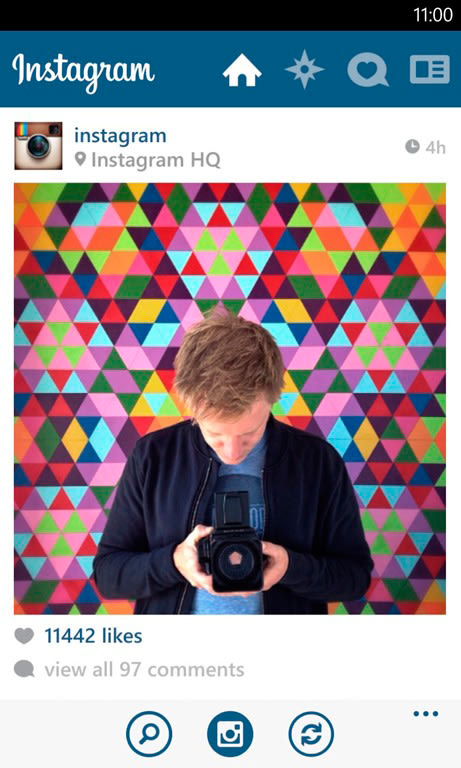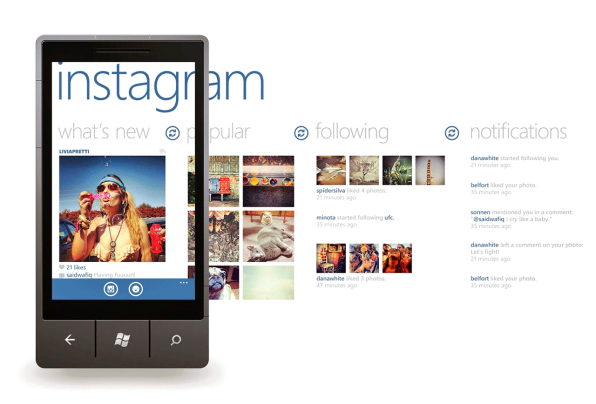Almost universally, critics laud Windows Phone, Microsoft's elegant and refreshing mobile OS. They also love many Windows Phone devices, especially Nokia's Lumia series of smartphones. But even with so much enthusiasm about the platform, Microsoft can't catch a break with customers, who always seem to eschew Windows Phone in favor of competing products from Google, Samsung, and Apple.
It's all about the apps. There are simply too many glaring holes in Microsoft's app catalogue.

Today the company plugs a big one: Instagram is coming to the Windows Phone platform. The popular photo-sharing service, which boasts more than 150 million users, has long been a sore point of differentiation for Redmond, a sign of the advantages Android and iOS had over Windows Phone. But Microsoft GM Casey McGee believes that narrative is starting to change. "Having Instagram is hugely symbolic," he says. "We really feel like we're turning the corner–that we've got that critical mass of applications that people want, which will encourage people to take a second look [at us]."
McGee's not just speaking anecdotally. Windows Phone's market share grew by 156% last quarter, year-over-year, according to IDC. Still, it's nowhere close to catching up to iOS and Android, which collectively dominate the market; Microsoft's market share is at just 3.6%.
But Instagram could serve as a driving force to attract new customers–and a feature Microsoft is likely to play up in its advertising this holiday season. When Instagram first launched several years ago, it was famously iOS-only. The startup decided to keep it that way for some time, all the while goosing lust for the product on Android. When it finally ported the service to Google's mobile OS, downloads rocketed: 10 million users in just 10 days. Microsoft hopes Instagram will get the same kind of reception on Windows Phone. "It's the No. 1 most-searched-for app in the Windows Phone store," McGee says.
Instagram, which is owned by Facebook, has long been rumored to be coming to Windows Phone. Myriad stories (including my own) have popped up over the years, wrongly reporting that the app was coming to the platform. Instagram CEO Kevin Systrom and team smartly didn't deny many of the rumors, teasing that it would eventually arrive on Windows Phone. As he told me over the summer, when I asked about Instagram on Google Glass, "We're not yet on Blackberry or Windows Phone, so I think those will come before Google Glass–but I'm not saying those will come anytime soon."
It got to the point where Windows Phone SVP Joe Belfiore even jokingly tweeted, "Send FB message to Zuck and Systrom and tell them you want it!"
Finally Microsoft announced the app was officially on its way, and today it's available for download. However, many have questioned whether the Windows app is ready for market. For one, it's missing a slew of basic features, such as photo tagging and even in-app camera support–if you want to take pictures or videos using Windows Phone, you'll have to take them via the phone's camera app, then open the Instagram app, and upload them through the service. Critics such as The Wall Street Journal's Farhad Manjoo and Valleywag's Sam Biddle immediately jumped on the service for leaving out such core features. Former YouTube Product Manager turned VC Hunter Walk joked via Twitter, "Instagram for Windows Phone has address where you send your paper photos, wait 2-3 weeks for them to be scanned & then posted back to app."

Instagram, justifying the missing features, explained on its blog that it wanted to get the service on Windows Phone "as quickly as possible," which is confusing considering it's been three years since the app launched.
But McGee is happy enough having Instagram's service on the phone, however incomplete and unpolished. He says the app "really puts us over the top." Waze also released its app for Windows Phone today, and the company has announced that other popular apps such as Mint, Path, and Flipboard will soon arrive in its store.
Still, it's clear Windows Phone is remains the third choice for developers, behind iOS and Android (but ahead of BlackBerry). And even with Instagram in its library, the company is still missing some equally if not more so popular services, such as Uber and Snapchat.
Source: https://www.fastcompany.com/3021787/microsoft-rejoice-instagram-finally-comes-to-windows-phone
Posted by: tonyrohowetze0194669.blogspot.com